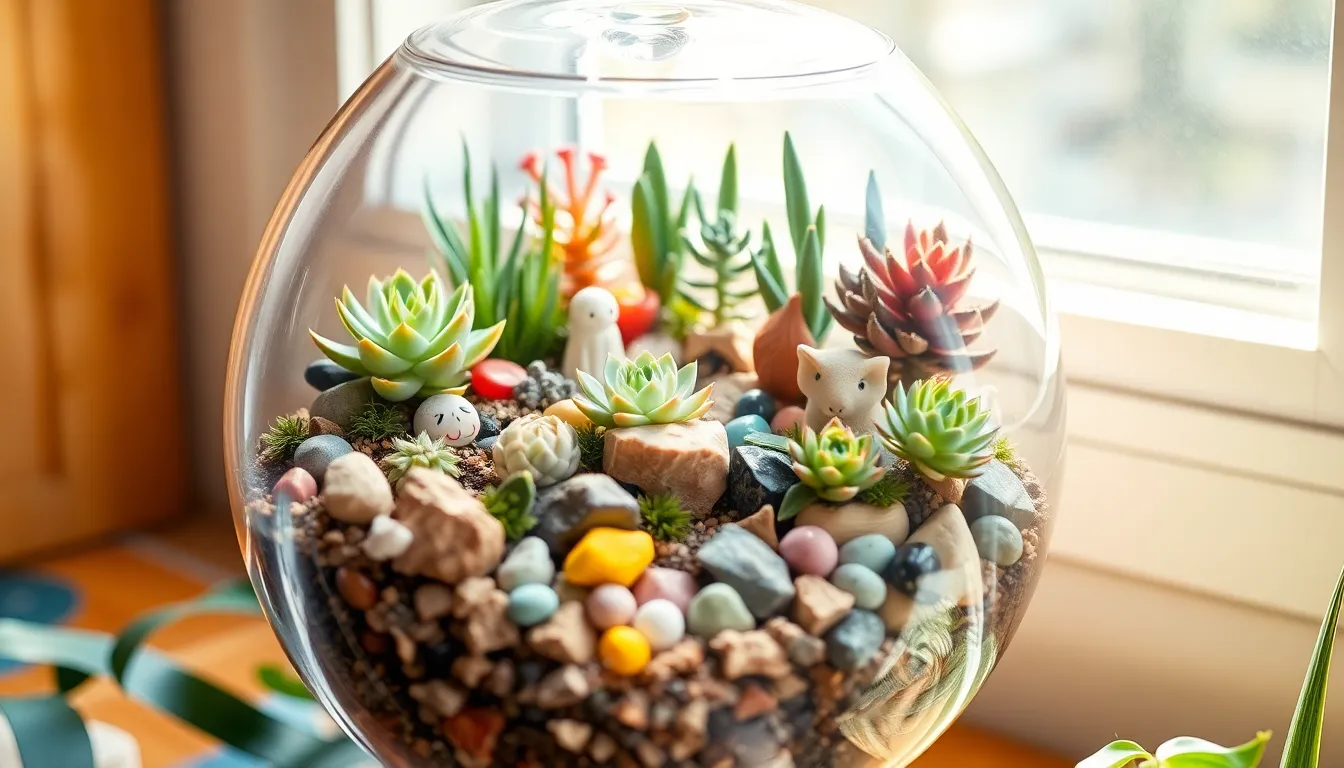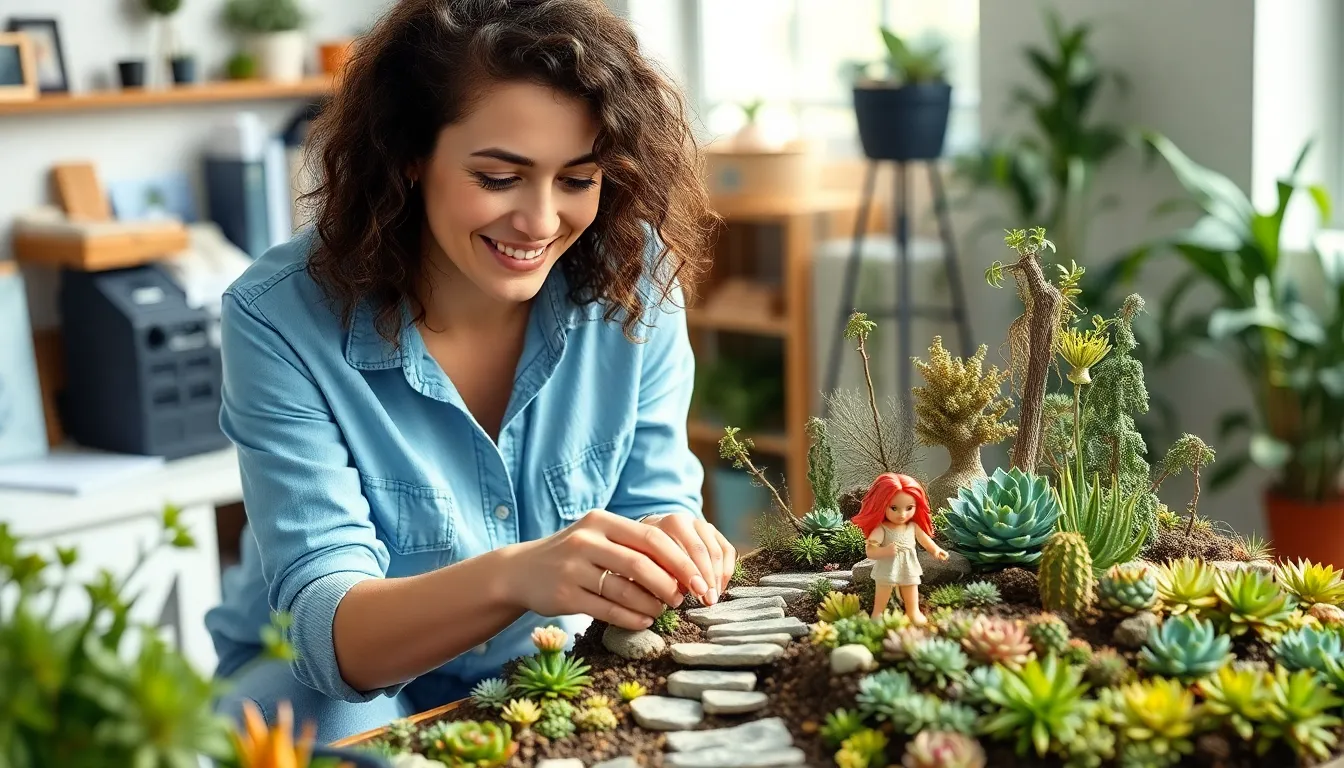Miniature gardens are enchanting worlds that invite creativity and imagination. These tiny landscapes, often featuring intricate details, provide a unique way to connect with nature, no matter the size of one’s living space. Whether it’s a whimsical fairy garden or a serene Zen landscape, the possibilities are endless.
Creating a miniature garden offers not just a fun hobby but also a chance to express one’s personality and style. With a variety of plants, decorative elements, and themes, anyone can transform a small area into a captivating retreat. As more people seek ways to bring nature indoors, miniature gardens have become a popular trend, appealing to both seasoned gardeners and newcomers alike.
Table of Contents
ToggleWhat Are Miniature Gardens?
Miniature gardens are small-scale landscapes that replicate natural settings. Typically, these gardens encompass various elements like plants, pathways, and decorative features, all crafted within a confined space. They often include a mix of materials such as soil, stones, and small structures, creating intricate scenes that cater to diverse themes.
Miniature gardens serve as personal expressions, allowing gardeners to create unique designs. Some popular styles include:
- Fairy Gardens: Incorporate whimsical elements like miniature houses and figurines, attracting a sense of magic.
- Zen Gardens: Emphasize tranquility and simplicity, featuring stones, sand, and minimalistic plants for a serene atmosphere.
- Succulent Gardens: Use drought-resistant plants to create vibrant and low-maintenance landscapes.
Miniature gardens are versatile, fitting various spaces, from small balconies to desktop environments. Their compact nature makes them ideal for urban dwellers seeking a touch of greenery. Both indoor and outdoor options exist, allowing flexibility in design and placement.
Overall, miniature gardens provide a creative outlet, connecting individuals to nature while transforming limited spaces into microcosms of beauty and inspiration.
Types of Miniature Gardens

Miniature gardens come in various forms, each offering unique ways to create engaging landscapes. Both indoor and outdoor options provide diverse opportunities for creativity and personalization.
Indoor Miniature Gardens
Indoor miniature gardens thrive in controlled environments, allowing for creativity without outdoor constraints. Common types include terrarium gardens, which feature glass containers filled with soil, plants, and decorative elements. Desktop gardens utilize small planters to bring greenery into offices or homes, while fairy gardens often incorporate whimsical figurines and tiny structures. Indoor succulent gardens are popular due to their drought-resistant nature, requiring minimal care. These gardens fit easily on shelves, windowsills, or tables, enhancing interior spaces with vibrant life and color.
Outdoor Miniature Gardens
Outdoor miniature gardens expand creative possibilities in natural sunlight. One popular style is the fairy garden, featuring miniature houses, pathways, and floral accents that attract playful imagination. Zen gardens focus on elements like rocks and gravel arranged for serenity and reflection, creating a peaceful retreat. Container gardens make use of pots and decorative setups, providing flexibility in design and placement throughout patios or yards. Each type supports a variety of plants, from flowering species to drought-tolerant varieties, making them adaptable to different climates and aesthetic preferences.
Benefits of Creating Miniature Gardens
Miniature gardens offer numerous advantages, enhancing both living spaces and the well-being of those who create them. The benefits range from visual aesthetics to mental health improvements.
Aesthetic Appeal
Miniature gardens provide striking visual interest, showcasing creativity through design and plant selection. Gardeners can experiment with various themes, colors, and textures to create unique scenes that capture the eye. Elements may include succulents, flowers, decorative stones, and miniature figurines that contribute to the overall charm. These gardens can serve as focal points indoors or outdoors, elevating the aesthetic quality of any area. Placing miniature gardens in strategic locations, such as coffee tables or window sills, enhances room decor while promoting a connection to nature.
Therapeutic Effects
Miniature gardens have therapeutic benefits that positively impact mental and emotional well-being. Engaging in gardening activities promotes relaxation and reduces stress levels, as caring for plants fosters mindfulness and a sense of calm. The process of creating these gardens encourages creativity, allowing individuals to express themselves through artistic design. Studies show that interaction with plants can boost mood and enhance focus, making miniature gardens a beneficial addition to personal or shared spaces. Furthermore, the satisfaction derived from nurturing a miniature garden stems from witnessing growth and change, reinforcing a sense of accomplishment and connection to life.
Essential Elements of Miniature Gardens
Miniature gardens combine various elements to create enchanting landscapes in small spaces. Key components include plants and accessories, each contributing to the overall theme and aesthetic.
Plants and Foliage
Plants play a crucial role in miniature gardens, providing texture, color, and life. Common choices include:
- Succulents: These drought-resistant plants thrive in minimal soil and require little water, making them ideal for low-maintenance gardens.
- Herbs: Varieties like thyme and basil not only add greenery but also impart pleasant scents and culinary uses.
- Mosses: These soft, lush foliage types introduce a natural carpet effect, enhancing the overall appearance.
- Dwarf Varieties: Smaller plants, such as dwarf conifers or miniature flowering species, help maintain scale and proportion in the garden.
Selecting the right mix of plants caters to specific themes while ensuring the garden remains vibrant and engaging.
Accessories and Decor
Accessories and decorative features enrich the miniature garden’s narrative and charm. Essential items include:
- Miniature Structures: Tiny houses, bridges, or fences establish focal points, inviting imagination and storytelling.
- Figurines: Character figures, animals, or garden gnomes add whimsy and personality, enhancing the garden’s charm.
- Pathways: Small stones, gravel, or wood chips create defined routes, guiding the eye through the landscape.
- Lighting: Miniature solar lights or fairy lights introduce evening ambiance and bring the garden to life after dark.
Incorporating these elements in a cohesive manner further personalizes the miniature garden, transforming it into a unique representation of its creator’s vision.
Miniature gardens offer a unique blend of creativity and tranquility that resonates with gardeners of all skill levels. They serve as a perfect solution for those seeking to incorporate nature into their lives, regardless of available space. With endless design possibilities and the ability to personalize each garden, individuals can express their style while enjoying the therapeutic benefits of gardening.
Whether it’s a whimsical fairy garden or a serene Zen setting, these small landscapes create captivating focal points that enhance any environment. As more people embrace the joy of miniature gardening, it’s clear that these enchanting creations will continue to inspire and connect individuals to nature for years to come.







